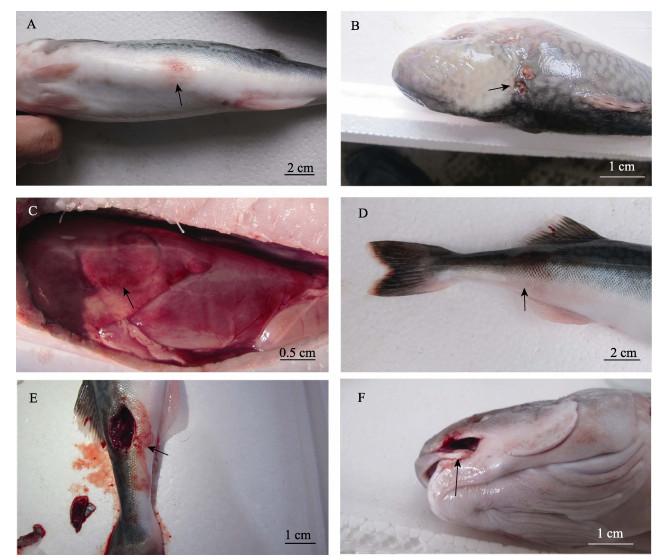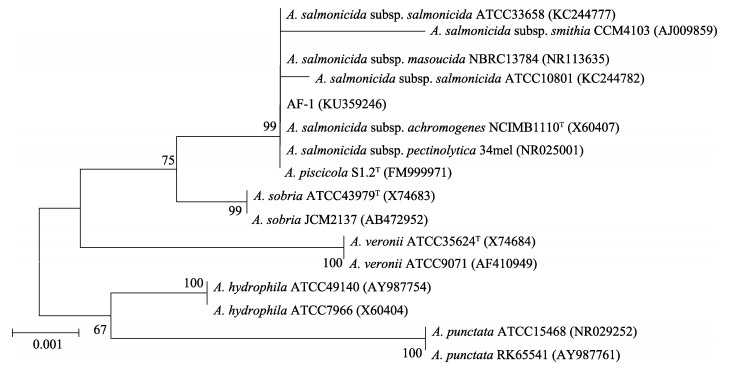2. 农业部海水养殖病害防治重点实验室 中国水产科学研究院黄海水产研究所 青岛 266071;
3. 青岛海洋科学与技术国家实验室 海洋渔业科学与食物产出过程功能实验室 青岛 266071;
4. 烟台海益苗业有限公司 烟台 265619
2. Key Laboratory of Maricultural Organism Disease Control, Ministry of Agriculture, Yellow Sea Fisheries Research Institute, Chinese Academy of Fishery Sciences, Qingdao 266071;
3. Laboratory for Marine Fisheries Science and Food Production Processes, Qingdao National Laboratory for Marine Science and Technology, Qingdao 266071;
4. Yantai Haiyi Seeds Co., Ltd, Yantai 265619
裸盖鱼(Anoplopoma fimbria)隶属于辐鳍鱼纲(Actinopterygii)、鲉形目(Scorpaeniformes)、黑鲉科(Anoplopomatidae)、裸盖鱼属(Anoplopoma),分布于北太平洋沿岸,包括自墨西哥北部至白令海的北美洲沿海和自勘察加半岛至日本东北部的亚洲沿海地区。裸盖鱼属于偏杂食的肉食性鱼类(刘春胜等, 2015),年均增重2000 g左右,最适生长温度为10–13℃,即使在夏季高温季节,裸盖鱼增重速度仍与适温条件下的半滑舌鳎(Cynoglossus semilaevis)和大菱鲆(Scophthalmus maximus)相同(陈昭廷等, 2015)。裸盖鱼肌肉富含多种营养物质,如不饱和脂肪酸(刘长琳等, 2015),具有极高的养殖价值。
裸盖鱼早期仅在加拿大地区有小规模的工厂化养殖(Hannah et al, 2013),作为一种适合于黄海冷水团养殖的名贵鱼种,2013年裸盖鱼被引入我国,并在山东烟台试养成功。2015年,裸盖鱼国内养殖和繁育技术获得突破,并在山东烟台地区开展工厂化繁殖和养成,但目前国内和国际上裸盖鱼养殖病害的研究报道相对匮乏,早期从海捕野生裸盖鱼个体中分别检测到杀鲑气单胞菌(Aeromonas salmonicida)和鲑肾杆菌(Renibacterium salmoninarum)感染的病例(Evelyn, 1971; Bell et al, 1990);Kent等(1998)对大西洋鲑(Salmo salar)网箱附近野生裸盖鱼调查发现,养殖大西洋鲑的微孢子虫(Loma spp.)等病原具有侵染裸盖鱼的能力。关于养殖裸盖鱼,目前只有加拿大不列颠哥伦比亚大学的评估报告对病害情况进行了简短的总结(Sumaila et al, 2005)。
2015年11月,烟台一养殖场繁育养殖的裸盖鱼出现疥疮病症状,自组织中分离得到一株优势菌,并进行了人工感染实验、生理生化鉴定、抗生素敏感检测及16S rRNA和gyrB基因序列分析,确定了病原菌的致病性、分类地位和耐药性,为我国人工繁育和养成裸盖鱼的细菌病防治提供了参考。
1 材料与方法 1.1 病鱼来源发病裸盖鱼采集自山东烟台某一个养殖场,本地繁育和养成,8月龄,鱼体重400–600 g,工厂化流水养殖,养殖水温约为15℃。
1.2 病原菌分离从发病裸盖鱼的溃烂部位、脓肿部位、肝脏、脾脏和肾脏取样,划线TSA和2216e平板培养基,20℃培养48–72 h,将获得的优势菌落进行纯化培养,分离纯化后的菌落采用20%的甘油保存于–80℃冰箱备用。
1.3 病原菌的人工感染通过肌肉注射方式对裸盖鱼进行人工感染。将分离菌株接种于TSB液体培养基,20℃摇床培养36 h。离心收集菌体,用生理盐水重悬细菌,调节细菌浓度至OD600 nm=0.5,此时细菌浓度约为1×108 CFU/ml。用生理盐水将菌液稀释至1×107 CFU/ml。选择400 g左右裸盖鱼,通过背部肌肉注射方式进行感染,每尾鱼注射0.2 ml 1×107 CFU/ml菌液,共注射6尾;对照组注射等体积的灭菌生理盐水。每天正常饲喂、换水,记录发病和死亡情况,对死亡的鱼及时解剖,并对病原进行分离。
1.4 病原菌的生理生化特征和药物敏感性分析采用革兰氏染色法对细菌进行染色镜检;采用微生物鉴定系统API-ID32E生理生化检测试剂盒(梅里埃公司, 法国),参照产品使用说明书进行生理生化特征测定;采用药敏检测试剂盒ATB-VET(梅里埃公司, 法国),对菌株进行药物敏感性检测;选择氟苯尼考药敏纸片(杭州微生物试剂有限公司)测定菌株对氟苯尼考的敏感性。
1.5 病原菌16S rRNA和gyrB基因序列测定利用16S rRNA通用引物27 F(5'-AGAGTTTG-ATCCTGGCTCAG-3',对应大肠杆菌8–27 bp)和1492 R(5'-RGGTTACCTTGTTACGACTT-3',对应大肠杆菌1492–1510 bp),PCR扩增AF-1 16S rRNA序列;按照已有文献报道的条件,扩增菌株的gyrB基因(Küpfer et al, 2006)。将扩增得到的PCR产物送至上海桑尼生物科技有限公司进行测序,获得的序列信息在GenBank中用Blast(http://blast.ncbi.nlm.nih.gov/)进行同源性比较,利用MEGA 5.05软件,采用邻位相连法(Neighbor-Joining)构建系统进化树(Bootstrap=1000)。
2 结果 2.1 病鱼症状、病原分离及人工感染发病裸盖鱼体表有少量出血点和溃烂,腹鳍出血,嘴角溃烂,严重者体表有脓肿;病鱼肝脏、肠壁充血(图 1)。

|
图 1 发病裸盖鱼症状 Figure 1 The clinical symptoms of diseased sablefish A:腹部和腹鳍出血;B:体表溃烂;C:肝脏充血;D:尾部脓肿;E:脓肿内部溃烂;F:嘴角溃烂 A: Subcutaneous hemorrhage in the abdomen and the fin; B: Ulcer on the body; C: Liver congestion; D: Abscess in the tail; E: Ulcer inside of abscess; F: Ulcer in the mouth |
从病鱼的溃烂部位、疥疮、肝脏、脾脏和肾脏都得到菌落形态一致的优势菌,细菌在TSA平板上生长呈浅黄色不透明圆形菌落,在2216e琼脂平板上生长呈针尖状菌落。其中,脾脏、肾脏和疥疮部位含菌量较高。所有分离到菌株的菌落形态一致,16S rRNA序列测定结果相似度大于99%,确定为同一菌株,命名为AF-1。
人工感染结果显示,注射感染菌株AF-1的裸盖鱼28 d内全部死亡,出现症状与自然发病一致,前21 d死亡5尾,主要表现为鱼鳍出血,体表有溃烂和出血点,22–28 d死亡1尾,在注射部位出现脓肿;死亡裸盖鱼解剖可见肝脏和肠壁充血。从人工感染发病的裸盖鱼体内重新分离到菌株,其菌落形态、生理生化特征和16S rRNA序列与AF-1一致,证明该菌株为此次裸盖鱼疥疮病的病原菌。
2.2 病原菌生理生化特征和药物敏感性革兰氏染色后光学显微镜观察显示,所有菌株均呈革兰氏阴性短杆菌;采用API ID32E系统鉴定菌株AF-1,反应结果见表 1。ATB系统数据库鉴定结果显示,菌株AF-1属于气单胞菌属,评语为“非常好的鉴定在属水平”;ATB-VET药物敏感性检测结果见表 2,AF-1对青霉素、阿莫西林、头孢噻吩等13种抗生素均具有耐药性,对氟甲喹等15种药物敏感;氟苯尼考药敏纸片测定结果显示,纸片抑菌圈大于9 cm,AF-1对氟苯尼考高度敏感,进一步指导养殖场采用氟苯尼考拌料投喂的方式进行治疗,对疾病起到了有效控制。
|
|
表 1 AF-1 API ID32E生理生化特征 Table 1 Biochemical reactions of AF-1 strain by API ID32E |
|
|
表 2 AF-1的药敏检测结果 Table 2 Antibiotics sensitivity of AF-1 |
利用PCR方法扩增裸盖鱼病原菌AF-1的16S rRNA和gyrB基因,得到16S rRNA(1430 bp)和gyrB (1042 bp)的基因序列,在GenBank的序列登录号分别为KU359246和KU362567。测序结果经过Blast比对分析显示,菌株AF-1基因序列在GenBank中同源性最高的几株菌为杀鲑气单胞菌。从NCBI数据库中选择多株气单胞菌属标准菌株的16S rRNA和gyrB基因序列,利用Mega 5.05软件构建系统进化树。16S rRNA进化树结果显示,AF-1与杀鲑气单胞菌和鱼蛭气单胞菌(Aeromonas piscicola)聚为一簇(图 2);gyrB进化树结果显示,AF-1与杀鲑气单胞菌的亲缘关系更高(图 3),综合生理生化和系统发育进化树结果,引起此次裸盖鱼疥疮病病原菌AF-1应为杀鲑气单胞菌。

|
图 2 基于16S rRNA序列构建的系统发育进化树 Figure 2 Phylogenetic tree constructed by neighbor joining method based on sequences of 16S rRNA |

|
图 3 基于gyrB序列构建的系统发育进化树 Figure 3 Phylogenetic tree constructed by neighbor joining method based on sequences of gyrB |
本研究从患疥疮病的养殖裸盖鱼中分离得到一株优势菌AF-1,人工感染实验表明,菌株AF-1可以感染正常裸盖鱼并引起体表出血、溃烂和脓肿等症状,与自然条件下发病症状一致。从人工感染患病裸盖鱼组织中重新分离到的细菌生理生化特征和16S rRNA基因序列与AF-1完全一致,证明AF-1菌株为此次裸盖鱼疥疮病的病原菌。
为鉴定病原菌AF-1的种类,本研究利用API ID32E试剂条对裸盖鱼病原菌进行生理生化鉴定,鉴定结果显示AF-1属于气单胞菌属。进一步选择了病原菌的2个管家基因(16S rRNA和gyrB)进行序列分析。16S rRNA基因在细菌进化中保守性高,在细菌分类鉴定和系统发育分析中应用广泛(陈文新, 1998),但由于鱼蛭气单胞菌(A.piscicola)与杀鲑气单胞菌相似度较高,通过16S rRNA无法完全区分(Beaz-Hidalgo et al, 2009),利用gyrB基因区分气单胞菌属的近缘种已有报道(Küpfer et al, 2007),因此,本研究同时选择了gyrB基因用于进化树分析,分析结果显示,菌株AF-1与杀鲑气单胞菌聚为一簇,属于杀鲑气单胞菌。杀鲑气单胞菌分为5个亚种,包括杀鲑亚种、杀日本鲑亚种、无色亚种、史氏亚种和溶果胶亚种(Holt et al, 1994; Pavan et al, 2000; Nash et al, 2006)。本研究分离得到的菌株AF-1尚无法确定所属亚种,下一步研究将选取更多的管家基因进行多位点序列分型(Multilocus sequence typing)研究,以确定AF-1所属亚种。
杀鲑气单胞菌是养殖鱼类的主要致病菌,可以引起鱼类皮肤脓肿、溃烂等疥疮病症状(McCarthy et al, 1977),在我国多种养殖鱼类中均有杀鲑气单胞菌感染的报道(李绍戊等, 2015; 王海娟等, 2015; 史秀杰等, 2007; 张晓君等, 2005)。近年来,在山东地区的养殖大菱鲆、大西洋鲑等冷水性鱼类中先后发现杀鲑气单胞菌感染的病例(吕俊超等, 2009; 衣萌萌等, 2015),本实验室也曾在烟台的发病大菱鲆中分离到杀鲑气单胞菌,这表明在我国的冷水性海水鱼养殖过程中,杀鲑气单胞菌是不可忽视的一类重要病原。
裸盖鱼属于冷水性养殖鱼类,加拿大裸盖鱼养殖评估报告指出,杀鲑气单胞菌可能是裸盖鱼养殖过程中的一个重要病原(Sumaila et al, 2005)。本研究首次报道了国内养殖裸盖鱼感染杀鲑气单胞菌的病例,并通过药物敏感性分析研究防治方法,采用氟苯尼考进行治疗并取得较好效果,为我国养殖裸盖鱼病害防治提供了技术措施。在今后的研究中,将针对裸盖鱼的杀鲑气单胞菌病原进行疫苗开发,为裸盖鱼的绿色健康养殖提供保障。
| Beaz-Hidalgo R, Alperi A, Figueras MJ, et al. Aeromonas piscicola sp. nov., isolated from diseased fish. Systematic and Applied Microbiology, 2009, 32(7): 471-479 | |
| Bell GR, Hoffmann RW, Brown LL. Pathology of experimental infections of the sablefish, Anoplopoma fimbria (Pallas), with Renibacterium salmoninarum, the agent of bacterial kidney disease in salmonids. Journal of Fish Diseases, 1990, 13(5): 355-367 DOI:10.1111/jfd.1990.13.issue-5 | |
| Chen WX. Bacterial phylogeny. Acta Microbiologica Sinica, 1998, 38(3): 240-243 [陈文新. 细菌系统发育. 微生物学报, 1998, 38(3): 240-243] | |
| Chen ZT, Chen SQ, Wang YT, et al. Growth characteristics of sablefish Anoplopoma fimbria in industrially farming. Fishery Modernization, 2015, 42(3): 12-16 [陈昭廷, 陈四清, 王有廷, 等. 温度对裸盖鱼工厂化养殖的影响. 渔业现代化, 2015, 42(3): 12-16] | |
| Evelyn TPT. An aberrant strain of the bacterial fish pathogen Aeromonas salmonicida isolated from a marine host, the sablefish (Anoplopoma fimbria), and from two species of cultured Pacific salmon. Journal of the Fisheries Board of Canada, 1971, 28(10): 1629-1634 DOI:10.1139/f71-243 | |
| Hannah L, Pearce CM, Cross SF. Growth and survival of California sea cucumbers (Parastichopus californicus) cultivated with sablefish (Anoplopoma fimbria) at an integrated multi-trophic aquaculture site. Aquaculture, 2013, 406-407(3): 34-42 | |
| Holt JG, Krieg NR, Sneath PHA, et al. Bergey's manual of determinative bacteriology. Ninth Edition, 1994, 251-253 | |
| Kent ML, Traxler GS, Kieser D, et al. Survey of salmonid pathogens in ocean-caught fishes in British Columbia, Canada. Journal of Aquatic Animal Health, 1998, 10(2): 211-219 DOI:10.1577/1548-8667(1998)010<0211:SOSPIO>2.0.CO;2 | |
| Küpfer M, Kuhnert P, Korczak BM, et al. Genetic relationships of Aeromonas strains inferred from 16S rRNA, gyrB and rpoB gene sequences. International Journal of Systematic and Evolutionary Microbiology, 2006, 56(12): 2743-2751 DOI:10.1099/ijs.0.63650-0 | |
| Liu CL, Chen SQ, Wang YT, et al. The analysis and evaluation of the nutritive composition of the muscles of sablefish (Anoplopoma fimbria). Progress in Fishery Sciences, 2015, 36(2): 133-139 DOI:10.11758/yykxjz.20150218 [刘长琳, 陈四清, 王有廷, 等. 裸盖鱼(Anoplopoma fimbria)肌肉的营养成分分析及评价. 渔业科学进展, 2015, 36(2): 133-139] | |
| Liu CS, Chen SQ, Wang YT, et al. Measurement of morphometric characters in 1-2-year-old sablefish, Anoplopoma fimbria. Fishery Modernization, 2015, 42(2): 23-27 [刘春胜, 陈四清, 王有廷, 等. 1-2龄裸盖鱼形态特征及其相关参数分析. 渔业现代化, 2015, 42(2): 23-27] | |
| Li SW, Wang D, Lian HM, et al. Isolation, identification and pathogenicity of Aeromonas salmonicida subsp. achromogenes from Atlantic salmon (Salmo salar). Acta Hydrobiologica Sinica, 2015, 39(1): 234-240 DOI:10.7541/2015.31 [李绍戊, 王荻, 连浩淼, 等. 大西洋鲑杀鲑气单胞菌无色亚种的分离鉴定和致病性研究. 水生生物学报, 2015, 39(1): 234-240] | |
| Lü JC, Zhang XH, Wang Y, et al. Isolation and identification of bacterial pathogen: Aeromonas salmonicida subsp. achromogenes in cultured turbot and histopathological study. Periodical of Ocean University of China (Natural Science Edition), 2009, 39(1): 91-95 [吕俊超, 张晓华, 王燕, 等. 养殖大菱鲆病原菌——杀鲑气单胞菌无色亚种的分离鉴定和组织病理学研究. 中国海洋大学学报(自然科学版), 2009, 39(1): 91-95] | |
| McCarthy DH, Skinner FA, Shewan JM. Some ecological aspects of the bacterial fish pathogen-Aeromonas salmonicida, Aquatic microbiology. Academic Press, 1977, 299-324 | |
| Nash JHE, Findlay WA, Luebbert CC, et al. Comparative genomics profiling of clinical isolates of Aeromonas salmonicida using DNA microarrays. BMC Genomics, 2006, 7(1): 43 DOI:10.1186/1471-2164-7-43 | |
| Pavan ME, Abbott SL, Zorzopulos J, et al. Aeromonas salmonicida subsp. pectinolytica subsp. nov., a new pectinase-positive subspecies isolated from a heavily polluted river. International Journal of Systematic and Evolutionary Microbiology, 2000, 50(3): 1119-1124 | |
| Shi XJ, Liu H, Gao LY, et al. Isolation and identification of causative agents of sick Arctic charr (Salvelinusal pinus). Journal of Huazhong Agricultural University, 2007, 26(2): 223-227 [史秀杰, 刘荭, 高隆英, 等. 患病北极红点鲑的病原分离与鉴定. 华中农业大学学报, 2007, 26(2): 223-227] | |
| Sumaila R, Volpe J, Liu Y. Ecological and economic impact assessment of Sablefish aquaculture in British Columbia. Fisheries Centre Research Reports, University of British Columbia, 2005, 13(3): 33 | |
| Wang HJ, Wang L. Identification and antibiotic resistance analysis of Aeromonas salmonicida isolated from Cyprinus carpio. China Animal Husbandry & Veterinary Medicine, 2015, 42(1): 192-196 [王海娟, 王利. 鲤鱼杀鲑气单胞菌的分离鉴定及耐药性分析. 中国畜牧兽医, 2015, 42(1): 192-196] | |
| Yi MM, Sun GX, Du YS, et al. The impacts of Aeromonas salmonicida on swimming behavior and numbers of blood cells of Atlantic salmon (Salmo salar L. ). Journal of Fishery Sciences of China, 2015, 22(1): 121-128 [衣萌萌, 孙国祥, 杜以帅, 等. 杀鲑气单胞菌对大西洋鲑游泳行为和血细胞数量的影响. 中国水产科学, 2015, 22(1): 121-128] | |
| Zhang XJ, Fang H, Chen CZ, et al. Study on characterization of Aeromonas salmonicida subsp. flounderacida subsp. nov. from diseased stone flounder (Kareius bicoloratus). Oceanologia et Limnologia Sinica, 2005, 36(1): 51-60 [张晓君, 房海, 陈翠珍, 等. 石鲽(Kareius bicoloratus L.)源杀鲑气单胞菌杀鲽亚种生物学性状的研究. 海洋与湖沼, 2005, 36(1): 51-60] |




